
Working at Heights – Extension Ladders Explain dangers Extension ladders can be dangerous tools. Workers have been killed and injured from falls and powerline contact. Identify controls • Choose the […]

Working at Heights—Site-specific Training Explain dangers Falling from heights continues to be a leading cause of injuries and fatalities in the construction industry. Despite the introduction of standardized working at […]

Working at Heights Fall Protection Rope Grabs Explain dangers With rope grabs, there are three basic hazards: 1. Attaching them the wrong way 2. Grabbing hold of them during a […]

Working at Heights – Fall Protection Approvals and Inspections Explain dangers When you’re using a travel restraint or fall arrest system, your life depends on your equipment. If it is […]

Working at Heights – Fall protection Basic types Explain dangers Falls are the number-one cause of accidental deaths and critical injuries in construction. And you don’t have to fall far […]

Working at Heights – Guardrails Explain dangers Falls are the number one cause of critical injuries and deaths of Ontario workers on construction sites. All workers must be protected from […]

Personal Protective Equipment – Head protection A 70-lb metal beam fell from the seventh storey of a condominium development and struck a worker on the head, face, and torso. The […]

Personal Protective Equipment – Hand Protection Explain dangers The best tools we have are our hands. We need to protect them on the job. Manual work exposes our hands to […]

Personal Protective Equipment – Respirators Maintenance Explain dangers To provide protection, respirators must be properly maintained. Dirty, missing, or damaged parts can prevent your respirator from working properly. For instance, […]

Personal Protective Equipment – Respirators – Fit Explain dangers With respirators, one size doesn’t fit all. Even with three different sizes of facepieces, for instance, no one size from one […]
